THE NEW HAMPSHIRE AIR NATIONAL GUARD
AT GRENIER FIELD
1947-1966
by
Tom Hildreth
ROOTS OF THE NHANG
During World War II, the 529th Fighter-Bomber Squadron (FBS) operated in the
China-India-Burma (CBI) theater of operations as one of three squadrons assigned
to the 311th Fighter Group (FG). The unit flew the North American A-36, which
was an early fighter-bomber version of the P-51 Mustang fighter. Operating from
Nawadih, India from 17 September 1943, the 529th was reassigned to bases in
China beginning 23 August 1944, and remained in that country until 14 December
1945. The squadron was inactivated on 6 January 1946, and on 24 May of that year
was redesignated the 133d Fighter Squadron (FS) and allocated to the National
Guard. The present-day New Hampshire Air National Guard is a descendant of the
organization described above.
THE AIR GUARD STRUGGLES TO EXIST
While the 529th was busy establishing its combat record in
the CBI, select Army leaders were looking ahead, planning for a postwar Army.
Among these military planners were a number of generals who felt a large active
duty Army was the way to a secure future. This powerful group included some who
were supporting the formation of an independent Air Force in the postwar period.
National Guard leadership was excluded from these early meetings because the
brass saw no role for the Guard in the postwar period. This point of view stood
only as long as one overlooked recent history. During the First World War, the
National Guard contributed 18 of 43 divisions of the American Expeditionary
Force. In the Second World War, 8 of 14 American divisions deployed overseas by
the end of 1942 were of National Guard origin. A longer look at history showed
that American dependence on the citizen soldier was an established tradition,
the cornerstone of a nation that did not favor a large standing Army.
The internal power struggle of the generals continued
throughout 1944. Early that year, Maj. Gen Ellard A. Walsh was president of the
National Guard Association (NGAUS). Walsh, a Minnesota Guardsman, stressed in
Washington that the National Guard's role of first-line combat reserve with dual
state-federal status should be preserved. The Army quickly came to the
understanding that the National Guard had considerable political support on
Capitol Hill. By May of 1945, the National Guard Bureau (NGB) had assumed a
position within the War Department that ensured a significant postwar role for
the reserve force. On 9 February 1946 the NGB officially announced the Air Guard
plan to the states and territories. On 30 June 1946, Colorado's 120th FS became
the first of the postwar National Guard units to be federally recognized.
NASCENCE
On 4 October 1946, the 133d Fighter Squadron was assigned to
the New Hampshire National Guard. Brig. Gen. Charles F. Bowen, Adjutant General
for the state was granted authority to recruit and organize 50 officers and 303
enlisted men for the 133d Fighter Squadron, which was to equip with the Republic
P-47 Thunderbolt. Supporting units were the 133d Utility Flight, Det B 201st Air
Service Group, and the 133d Weather Station. On the first evening drill, 13
officers and 14 enlisted men signed the 133d FS roster, while 2 officers and 22
enlisted men signed the roster of the 201st Air Service Group. On 14 April 1947,
the growing organization received federal recognition.
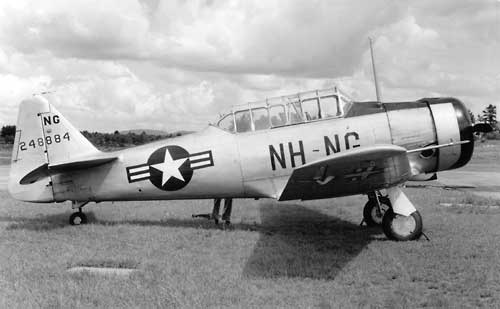
The very first aircraft to arrive at Manchester included a group of North American
T-6 Texans
such as this one photographed at Keene, NH by Paul. R. Trask. The state
lettering on the
fuselage indicates that these markings may have been applied before
the Air Force became an independent department of the US military.
The arrival of the first New Hampshire National Guard P-47s
took place at Grenier Field in Manchester on 28 May 1947. These Thunderbolts
were flown in from the large Air Depot at Olmstead Field, Middletown,
Pennsylvania by pilots from Dow Field in Bangor, Maine. Aircraft maintenance
officer Capt. Stanley Drinkwater, tech supply officer 1Lt. John D. Woodward, and
supply clerk Ernest Purcell were on temporary tours of duty (TDY) at Olmstead
for training in supply procedures at this time. Eventually, 4 Douglas B-26 light
bombers, 4 North American AT-6A Texan trainers, and 2 C-47A Skytrain transports
arrived to equip the burgeoning establishment.
Lt. Col. Charles G.Y. Normand, a New Hampshire native and decorated fighter
pilot took command of the 133d on 7 November 1947. Normand guided the 133d
through many start-up problems shared by National Guard units everywhere at this
time. Equipped with a large number of aircraft, parts for the fleet were hard to
get, and paychecks were often late. Recruitment was a top priority, and most of
the early members of the establishment were World War II veterans. The unit
drill periods were scheduled for two Tuesdays per month, while flying missions
took place on a more random basis as the pilots found time. The pay for an NCO
was $2 per drill, while a full-time maintenance technician, hand-picked by the
adjutant general earned about $50 per week.
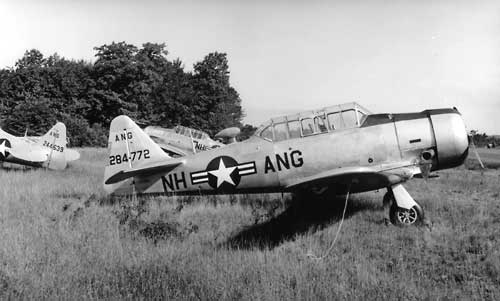
T-6D Texan 42-84772 of the 133d FS photographed by W.J. Balogh, Sr. in
the late 1940s.
The goal of creating a separate Air Force was realized on 18
September 1947 when the National Defense Act led to the organization of the
United States Air Force (USAF). From this point on, the units at Grenier Field
would be known as Air National Guard (ANG) organizations.The first Annual
Training (AT) period consisted of a summer deployment to Dow Field in Bangor,
Maine in 1948. The 133d FS and its supporting units joined with other units of
the parent 101st FG, which included the 132d FS, Maine ANG and the 134 FS,
Vermont ANG during this first training period. On 1 December 1948 the 101st FG
was transferred from the First Air Force to the Continental Air Command (CONAC).
Below: Republic F-47 Thunderbolt at Grenier Field in the early
days of the New Hampshire ANG
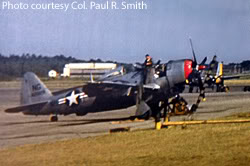
THE UNIT MATURES
By 1949 Lt. Col. Normand's recruitment efforts succeeded, and
the unit was fully manned. In March of that year, Lt. Col. Lauren A. Howard
became commander of the 133d. As unit training continued, personnel became more
proficient in their specialties. The 133d FS settled into the peacetime routine
of a military flying organization, highlighted by monthly drills and summer
camps, all punctuated by the comings and goings of the big Republic
Thunderbolts. Equipment modernization was taking place however, and during the
1949 summer camp, the 132d FS at Dow was sporting sleek new Lockheed F-80C jet
fighters, while members of the other two squadrons looked on in envy.
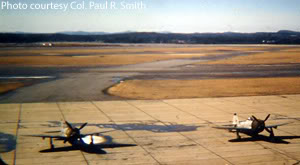 Right: Two F-47 Thunderbolts of the 133d Fighter Squadron
Right: Two F-47 Thunderbolts of the 133d Fighter Squadron
repose on the ramp outside the main hangar.
Runway
17-35 can be seen running left to right in the background
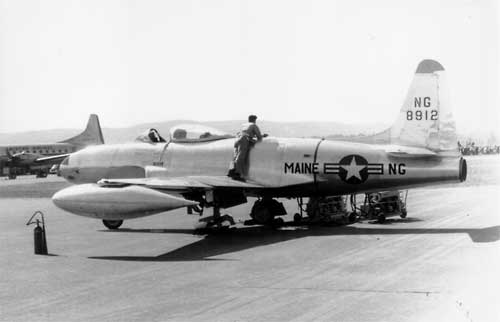 Left: Prior to the outbreak of the Korean War, the Air Guard was
Left: Prior to the outbreak of the Korean War, the Air Guard was
rapidly modernizing, as shown in this 1949 photo of a Lockheed
F-80C Shooting Star. Photo courtesy 104FW MA ANG.
FEDERALIZATION
On Sunday, 25 June 1950 Communist North Korea invaded the
Republic of South Korea (ROK). The U.S. Korean Military Advisory Group (KMAG)
had been assisting the ROK forces, and at 1900 hours six North Korean YAK
fighters strafed Kimpo Airfield, destroying a USAF C-54 transport on the ground.
The ROK army was unable to stop the rapidly advancing North Korean forces, and
protection of American citizens evacuating from South Korea became an essential
USAF responsibility. The United States was quickly drawn into the Korean War.
Russia had become a nuclear power in 1949 when the communist
nation exploded its first nuclear bomb. The U.S. was not willing to risk a
nuclear exchange over Korea, and this meant that the greatly downsized United
States military forces suddenly faced the prospect of conventional ground
warfare against the large communist North Korean army. The U.S. was not prepared
to do this with active duty forces alone. It could only be accomplished through
the call to active duty of reserve forces of all the branches of the U.S.
military.
On 1 February 1951 the 101 FG was federalized and called to
active duty as part of the 4707th Defense Wing at Otis AFB, Massachusetts. By 25
February the 132d FS at Dow had converted from the F-80 jet to the North
American F-51 Mustang. Over at Burlington, Vermont, the 134th FS had converted
to Mustangs in July of the previous year. This left the 133d at Grenier as the
only squadron of the 101 FG operating the venerable F-47s. All three of the
squadrons functioned as CONAC-assigned units from their respective home bases
for the duration of their active duty periods. Gunnery training sorties were the
most common missions during this period. The 133d supplied 3 F-47s and pilots to
bolster the active-duty Air Force's 74th Fighter Interceptor Squadron (FIS) that
was flying the F-86A Sabrejet at Presque Isle AFB, in northern Maine.
RETURN TO STATE CONTROL
During this early period in ANG history, basic training was
often accomplished at home base, and it would not have been wise to try to
integrate new recruits who did not have basic military training with the parent
unit while it was on active duty. In mid-1952, the 8133d Squadron was
established at Grenier Field as an interim "holding" unit for new airmen. On 1
November 1952 the 133d, re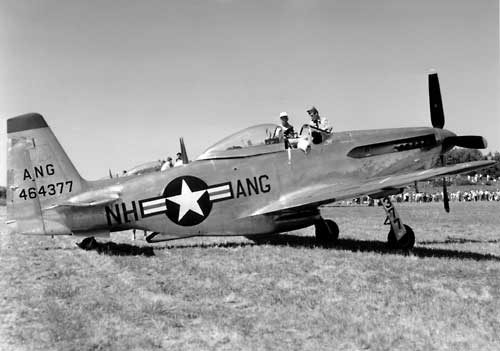 designated as the 133d FIS, was returned to state
control. A number of the 133d members had been reassigned to support other USAF
units and their return would take several months. The 8133d personnel were soon
integrated into the 133d at Grenier Field.
designated as the 133d FIS, was returned to state
control. A number of the 133d members had been reassigned to support other USAF
units and their return would take several months. The 8133d personnel were soon
integrated into the 133d at Grenier Field.
The mission provided by the 133d and other units during their
active duty Korean War callup was essential to the Air Force, which was forced
to activate interceptor squadrons to replace the ANG units at numerous locations
in the US. At Manchester the Air Force briefly activated the 48th FIS on the
same day the 133d was returned to state control. The 48th operated F-47
Thunderbolts, likely those passed on to them by the NHANG, which had begun to
reequip with the North American F-51H Mustang.
RIGHT: North American F-51H photographed by Paul S. Trask at Keene, NH. This was a postwar
version of the famous Mustang fighter, and it served with many ANG units throughout the
country. Several years prior to this, the F-51H served with the Strategic Air Command's
(SAC) 82d Fighter Group at Grenier Field. As with most other F-51H units, the 133d eventually
equipped also with a number of F-51D aircraft.
THE JETS ARRIVE
The transition to jet aircraft at Manchester took place under
the watchful eye of Maj. Paul R. Smith, a veteran of 77 combat missions in
Thunderbolts in the European Theater during the Second World War. Smith joined
the NHANG in 1947, and became the 133d
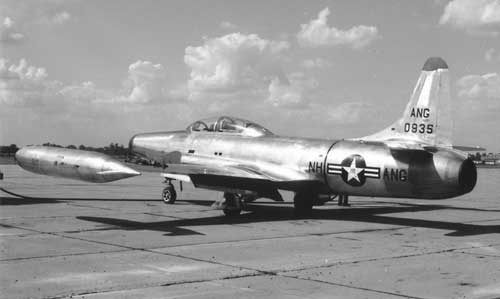 FS Operations Officer. He served two
years of active duty during the Korean War, and later graduated from USAF Air
Command and Staff School. Maj. Smith took command of the 133d FIS on 11 January
1953.
FS Operations Officer. He served two
years of active duty during the Korean War, and later graduated from USAF Air
Command and Staff School. Maj. Smith took command of the 133d FIS on 11 January
1953.
Left: Lockheed F-94B Starfire of the 133d FIS photographed by W.J. Balogh, Sr. This
aircraft was a two-seater, with a pilot in front and radar operator in back.
Never a stellar performer, it was capable of limited all-weather intercept
operation.
Two T-33 jet trainers arrived in 1953, along with two B-25
Mitchell bombers. On 12 December 1953, Gen. Bowen announced the 133d would
transition to the two-place Lockheed F-94A/B Starfire jet interceptor. These
aircraft were more complex than any of the previous types operated by the NHANG, and $1,750,000 in federal funding was earmarked for a permanent facility at
Grenier Field for the 133d. Much of the activities of the unit to this point had
been conducted from the World War II facilities that had been Grenier Army
Airfield.
The first Starfires arrived on 9 June 1954. With most ANG
units, training for the back seat radar observer was accomplished by the TB-25K
Mitchell bomber, which was modified with a nose radar identical to that of the
Starfire. The trainee sat at a position inside the bomber equipped with a radar
scope. Unlike later interceptor aircraft, the Starfire was not an automated
platform. Ground radar stations would steer the aircraft to a position in the
sky from which the aircraft's radar could pick up the target and the radar
observer would work with the F-94 pilot to track and close in on the target for
identification or shoot down. Lightly armed with four .50 cal. machine guns, the
A/B Starfires were equipped with afterburning engines for quick climb and
acceleration.
The 133d FIS often worked with the Air Defense Command's 762d
Aircraft Control & Warning (AC & W) Squadron at the N. Truro, Massachusetts
radar site on Cape Cod. The 762d operated a Gap Filler Annex (GFA) site at Rye
Air Force Station (AFS) beginning in 1951. This site is now known as Pt. Odiorne
State Park. In addition to this, a GFA was planned for Moultonborough, New
Hampshire, but was never built. According to retired NHANG personnel, the 654th
AC & W squadron at NAS Brunswick, Maine also directed the Starfires of the 133d
FIS.
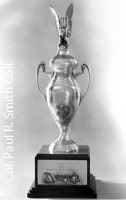
Left: The Winston P. Wilson Trophy was awarded to the 133d FIS for runway alert duty performed at
Manchester from October, 1954 until June, 1956. During this period, the unit flew numerous interecept
missions in defense of the greater Manchester area. The Wilson trophy recognized the 133d as the
outstanding Air Guard jet fighter unit of the day. Wilson was one of the most important leaders in
Air Guard history. He joined the Arkansas National Guard as a mechanic in 1929, became a pilot and
was later sworn in as Chief of the National Guard Bureau in 1963. At a time of great Air Force reluctance,
Wilson insisted that the Air Guard be given a wartime mission for which it would equip and train, while
enhancing its professional image and earning equal stature with the active-duty Air Force.
EXPANSION AND SABREJETS
The New Hampshire Air Guard attained Group status on 16 April
1956 with the activation of the 101st Fighter Interceptor Group (FIG) at Grenier
Field. The 133d FIS was the flying component of this new group, with the 101st
Group Headquarters, 101st Medical Squadron, 101st Air Base Squadron and the
101st USAF Dispensary rounding out the 400-man organization. By April 1958 the
133d FIS reequipped with 24 single-seat North American F-86L Sabrejets. This was
an aircraft with automated features, making it more complex and more demanding
to fly and maintain. More than a dozen of these swept-wing fighters were in
place by May, and the organizational manning grew to nearly 700 officers and
enlisted men.
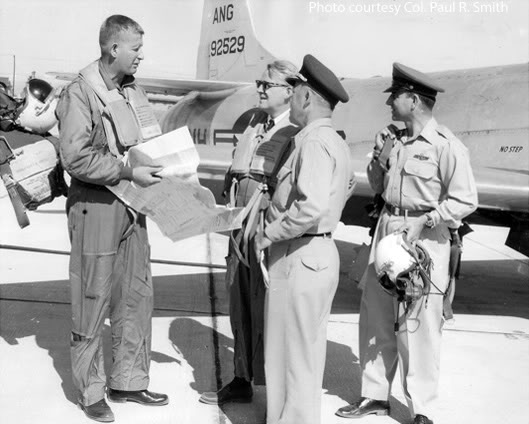
Right: Governor Lane Dwinnel and Pilot James E. Cuddihee
appear to be reviewing the flight chart alongside a Lockheed
F-94A Starfire interceptor. Photo from 1957-1958 period
The NHANG was destined to operate the F-86L Sabrejets for a
very short period of time, only about two years. It is easy to question the
proficiency level attained in this short time span. In fact, in "Granite Wings",
the official history of the NHANG, the section "Summer Camp, 1958" seems to
raise more questions than it answers. It is known that for "live fire" missions
with the F-86L, all units had to operate from bases in either Florida, or the
southwest USA. This is because the armament of the aircraft was the "Mighty
Mouse" air rocket, and there was no range in the northeast suitable for use of
this weapon. Still, the report states that of the 119 missions flown during the
summer camp at Otis AFB, MA five were gunnery missions. Further, NH Governor
Lane Dwinell visited the Guardsmen during the 1958 summer camp at Otis, and it
is reported that he, "....was fitted out with a flight suit and took a ride in a
Sabrejet fighter." It has since been determined that Governor Dwinell flew in a T-33A trainer,
as all F-86 Sabrejets were single-seat aircraft. The author feels it is possible the 119 gunnery missions were flown
in T-33 trainers armed with .50 cal machine guns.
Short though the F-86L Sabrejet's operational service with
the NHANG may have been, this situation was not unusual. There were 29 ANG
F-86D/L squadrons in 1959, with the majority of these units transitioning to
other aircraft types by 1963. Newer, more capable interceptors were entering
service with USAF, at a time when the perceived threat from Russian nuclear
bombers was beginning to decrease. By 1960, air defense of the continental
United States was in the early stages of a long decline. Only once, more than
forty years later, on 9/11/2001, would the country come to regret this trend.
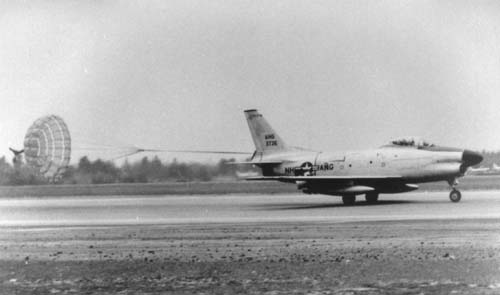
Right: In this Bob Raiche photo at Manchester we see an F-86L Sabre rolling out
on landing
with braking chute deployed. This was standard practice for these
fighters, heavily-laden with radar and data-link equipment operating
from relatively short runways.
THE HEAVY TRANSPORT BUSINESS
In January 1960 it was announced that the New Hampshire
Guardsmen would be the first of eighteen units to reequip with the Boeing C-97A
Stratofreighter. Manchester would be home to eight of the large four-engine prop
transports. Col. Paul R. Smith, 101st FG Commander, and Capt. James Cuddihee,
133d FIS Commander were the first from New Hampshire to be sent to Travis AFB,
California for training on the Stratofreighter. The first of the big transports
was scheduled to arrive in February 1960, and by 1 September 1960 the unit was
fully equipped as the 133d Air Transport Squadron (ATS), 157th Air Transport
Group (ATG) assigned to the 133d Military Air Transport Wing (ATW),
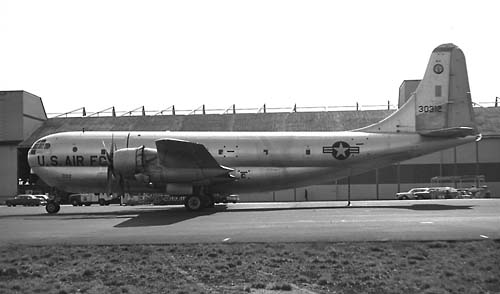 headquartered in Minnesota. The 133d ATW reported to the Military Air Transport
Command (MATS). Such were the global responsibilities of the Granite State
flyers that the qualification training for the first five-man crew involved a
trip to Japan. Group responsibilities broadened in January 1961 when the 133d
Aeromedical Evacuation Flight was federally recognized and attached to the 157th
ATG.
headquartered in Minnesota. The 133d ATW reported to the Military Air Transport
Command (MATS). Such were the global responsibilities of the Granite State
flyers that the qualification training for the first five-man crew involved a
trip to Japan. Group responsibilities broadened in January 1961 when the 133d
Aeromedical Evacuation Flight was federally recognized and attached to the 157th
ATG.
Boeing C-97A 53-0312 of the 133d ATS NHANG photographed by the author at
Bradley Field, CT in 1964.
FEDERALIZATION AGAIN
On 1 October 1961, in response to the Berlin Crisis, the 157 ATG and subordinate
units were federalized
and ordered to active duty. Most of the establishment's 675 Guardsmen would
perform duties at Grenier Field during the crisis, but the aircraft and aircrew
members would fly all over the world. Units of the Turkish Army were airlifted
to Korea, supplies were flown to West Berlin, and communications equipment was
delivered to Southeast Asia. On 31 August 1962, the 157th was returned to state
control.
GLOBAL AIRLIFT AFTER THE BERLIN CRISIS
In 1963 the 157th ATG participated in the first all-National Guard deployment of
troops to Alaska. Later, an all-National Guard airlift to Europe took place. In
1964 a NHANG crew became the first Air Guard team to fly nonstop from Japan to
Hawaii. Shortly after landing in Honolulu, Lt. Col. William J. Hamilton and crew
became the first Guard members to participate in a mid-Pacific search and rescue
mission. In April 1965, Hamilton would replace Col. Smith as 157th ATG
commander. Col. Smith was promoted to Chief of Staff for Air, NHANG. Between
November 26th and December 1st 1965, three NHANG C-97s, manned by volunteer
crews, participated in Operation Christmas Star in support of American troops in
Vietnam. In all, 23,000 lb. of cargo, which was entirely collected in the
Granite State was sent to Saigon and Da Nang. Following this, support missions
to Southeast Asia would become more routine for ANG crews.
In January 1966, the 157th Air Transport Group was renamed the 157th Military
Airlift Group (MAG) and attached to the 21st Air Force at McGuire AFB, NJ.
RELOCATION TO PEASE AFB
As part of mandated military downsizing, the Air Force was in the process of
streamlining. At Grenier Field, the Reserves 902d Troop Carrier Group with C-119
Flying Boxcars on the east side of the airport (where Wiggins Aviation is today)
was inactivated. The 157th was transferred with personnel and equipment east to
Pease AFB, New Hampshire. The final drill weekend in Manchester was January
15/16, 1966. It was not lost on many unit members that much of the Manchester
facility has been refurbished in 1958. Nevertheless, morale remained high during
this relocation. The move was completed, and the mission would continue. The
personnel and Stratofreighters of the 157th began operating out of the north
side of Pease AFB in February 1966.
THE END
NOTES
Four books were the primary sources of information in the
article above:
Charles J. Gross, The Air National Guard and the American Military Tradition, 1995, ISBN 0-16-048302-6
Lt. Col. Philip W. Sheridan and 157 ARW Staff, Granite Wings, A History of the New Hampshire Air National Guard, 1947-1998
Rene J. Francillon, The United States Air National Guard1993, ISBN 1-880588-03-X
Bill Green, The First Line1994, ISBN 0-9639657-0-0
The author welcomes contact with persons who have photos of NHANG aircraft and
facilities from the time period covered in this article. In particular, photos
of 133d F-47 Thunderbolt, C-47 Skytrain, B-25, B-26, C-45, C-47 and T-33A would
be most appreciated. (No calls please).
Tom Hildreth
72 Mountain View Street
Chester, Vermont 05143-9497
hildrethtom@hotmail.com





 designated as the 133d FIS, was returned to state
control. A number of the 133d members had been reassigned to support other USAF
units and their return would take several months. The 8133d personnel were soon
integrated into the 133d at Grenier Field.
designated as the 133d FIS, was returned to state
control. A number of the 133d members had been reassigned to support other USAF
units and their return would take several months. The 8133d personnel were soon
integrated into the 133d at Grenier Field.
 FS Operations Officer. He served two
years of active duty during the Korean War, and later graduated from USAF Air
Command and Staff School. Maj. Smith took command of the 133d FIS on 11 January
1953.
FS Operations Officer. He served two
years of active duty during the Korean War, and later graduated from USAF Air
Command and Staff School. Maj. Smith took command of the 133d FIS on 11 January
1953.



 headquartered in Minnesota. The 133d ATW reported to the Military Air Transport
Command (MATS). Such were the global responsibilities of the Granite State
flyers that the qualification training for the first five-man crew involved a
trip to Japan. Group responsibilities broadened in January 1961 when the 133d
Aeromedical Evacuation Flight was federally recognized and attached to the 157th
ATG.
headquartered in Minnesota. The 133d ATW reported to the Military Air Transport
Command (MATS). Such were the global responsibilities of the Granite State
flyers that the qualification training for the first five-man crew involved a
trip to Japan. Group responsibilities broadened in January 1961 when the 133d
Aeromedical Evacuation Flight was federally recognized and attached to the 157th
ATG.